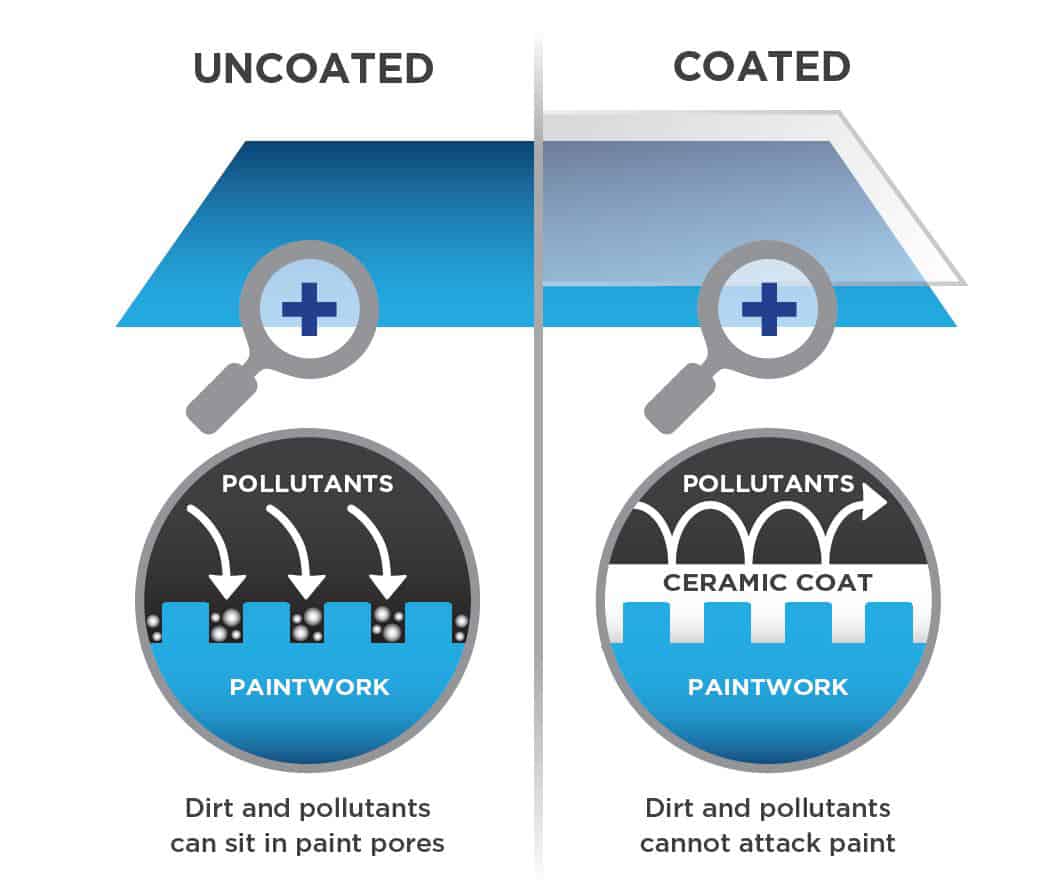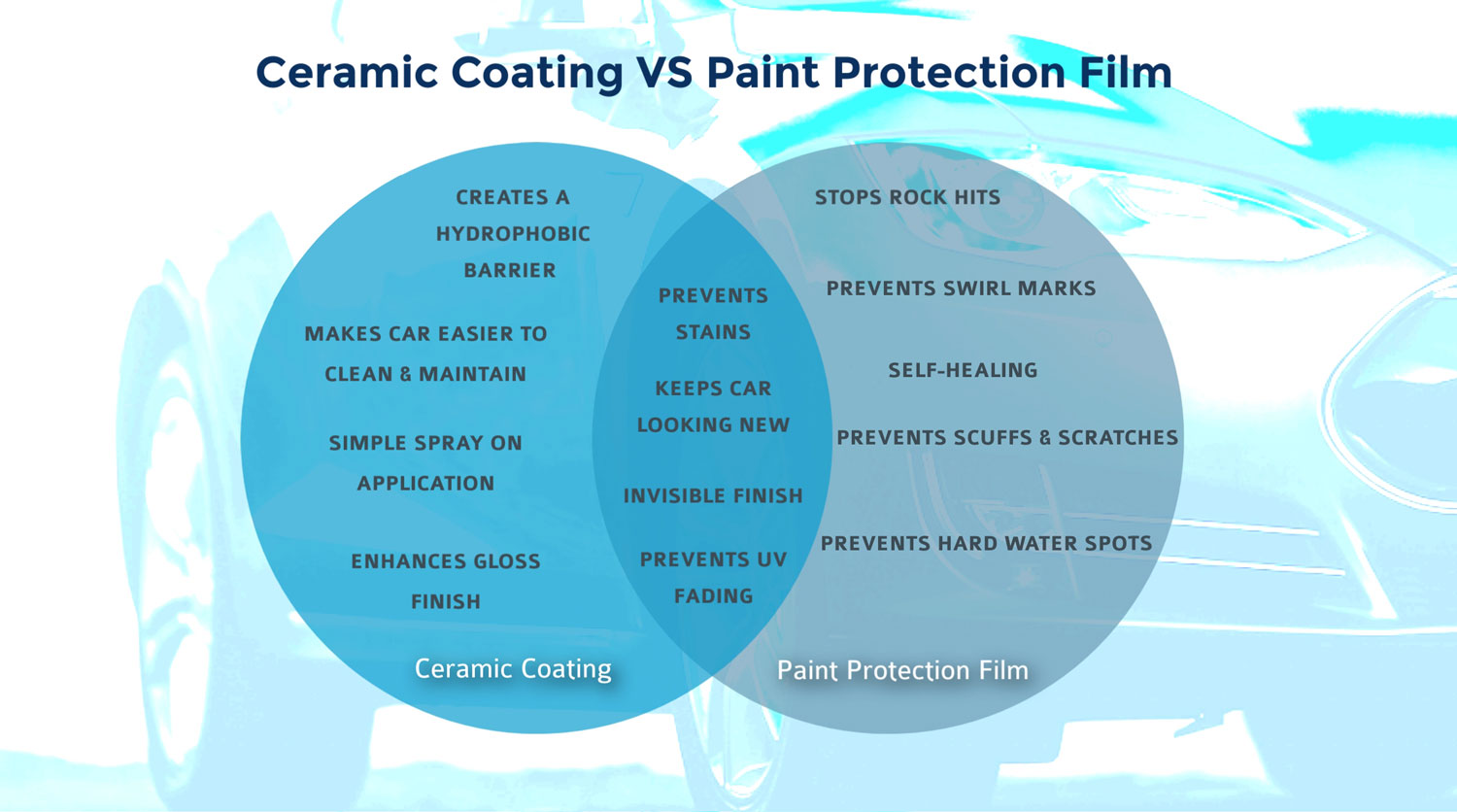Paint Protection Film or Ceramic Coating?
Ceramic Coating or Paint Protection Film?If you own a car it’s only natural to want to protect its appearance for as long as possible. And, in a world full of hazards — from bird droppings to salt to rock hits — you want a solution that works, is easy to install and won’t cost an arm and a leg. Tall order? No question but why settle for anything less?

If you’re still reading, we’re pretty sure you’ve already done a little research and you’ve figured out that there are two main ways to protect and preserve your car’s paint:
- Ceramic Coatings (such as Avalon King’s Armor Shield DIY Kit)
- Paint Protection Film (or Clear Bra, such as XPEL Ultimate and 3M™ Pro Series)
But, now that you’ve gotten this far you’re probably still wondering what the difference is between these two products and what exactly, they can do for your car. Which of these products is the best solution for protecting your car’s paint? Read on and find out.

What Is a Ceramic Coating?
A ceramic or nano-coating is a liquid polymer which is designed to apply to the exterior surfaces of a vehicle. After application, the nano-coating chemically bonds with the vehicle’s paint. This creates a layer of protection and a hydrophobic surface. Not sure what the word “hydrophobic” means? Well, you’re not alone but it’s pretty simple: it literally means “afraid of water” and it means that your car’s painted surface will reply water and contaminants. We’ve all seen the YouTube videos that show someone splashing mud or water onto a hood treated with Ceramic Coatings and are amazed when the stuff just beads up and slides off — this, my friends, is a hydrophobic surface in action. Naturally, such surfaces offer two primary benefits for the car owner:
- Nanoceramics keep the car cleaner for longer.
- Ceramic coatings make the car easier to clean when the time does come for a wash.
And, since Ceramic Coatings work by creating a chemical bond with the paint, they are uniquely suited to prevent chemical damage as well as damage due to UV exposure. However, there are whole host hazards that nanocoatings don’t protect your ride from and they are almost all mechanical in nature. In other words, coatings can’t protect your vehicle from rock hits, keys and any other physical object that has the potential to scratch your paint job.

How Do Paint Protection Films Work?
Paint protection films are made from polyurethane film with invisible adhesives and are intended to be applied to your factory paint job. They can vary in thickness from as few as 4 mils to as much as 8 mils and are designed to provide a physical barrier to mechanical damage from rocks, keys, gravel, salt, hail, sand, etc. Modern paint protection films generally feature a self-healing property which is the result of a polymeric topcoat so small scratches and scuffs will disappear. The image above (taken from XPEL) should give you a better idea of the way in which most paint protection films are construction (for reference, XPEL ULTIMATE is 8 mils thick).
In short, the upper layer of the PPF is constituted of an elastomeric polymer substance with a memory that helps the material maintain its shape once it’s been applied. The memory of the elastomeric topcoat allows the PPF to “self-heal” when light scratches or scuffs occur. This feature also reduces any potential, future swirl marks on the paint job – which is another benefit of paint protection films.
Similarities between Paint Protection Film and Ceramic Coatings
As you can see, both nanocoatings and protection films serve the purpose of keeping your car looking newer for longer although they differ in the way the do so. In addition to this common purpose, they both have some overlapping benefits and characteristics. Specifically, both coatings and PPF can help reduce damage from UV radiation and acidic pollutants. Whichever option you choose, you will certainly be protecting your investment for years to come.

Similarities between Paint Protection Film and Nano Ceramic Coating
We’ve said before but it bears repeating: due to the fact that Paint Protection Film is thicker than Ceramic Coating, it can protect your ride from things that a coating just can’t. Plus, PPF is self-healing meaning that it can return to its original form after being indented or abraded. As such, PPF is able to absorb rock chips, small scratches, swirl marks, and hard water spots without being permanently disfigured. Ceramic Coatings simply don’t have this capability, despite any claims of to the contrary. However, they do have their strengths, particularly in terms of the hydrophobic surface they are able to create. Finally, spray on coatings are much easier to apply than PPF which can be laborious and somewhat tricky to get the hang of.
Which to Choose: Ceramic Coating or Paint Protection Film?
Well, you made it and we’re sure you’re now expecting us to deliver our final judgment, most likely in favor of paint protection films (since we sell them after all). But, really, it’s a trick question because your best choice is not to choose at all. Instead, you should choose to use both so you can capitalize on their unique strengths which cancel out their respective weaknesses.
In short, apply PPF to all of the areas of your vehicle that are exposed to environmental and physical hazards. These areas include hoods, fenders, bumpers, roof, pillars and door cups to name a few. Once you have protected these areas with a premium protection film you will then apply a ceramic nano-coating to reap the hydrophobic benefits and increase the longevity of your film.
Find out more vinyl wrapping work in our Instagram and gallery.

